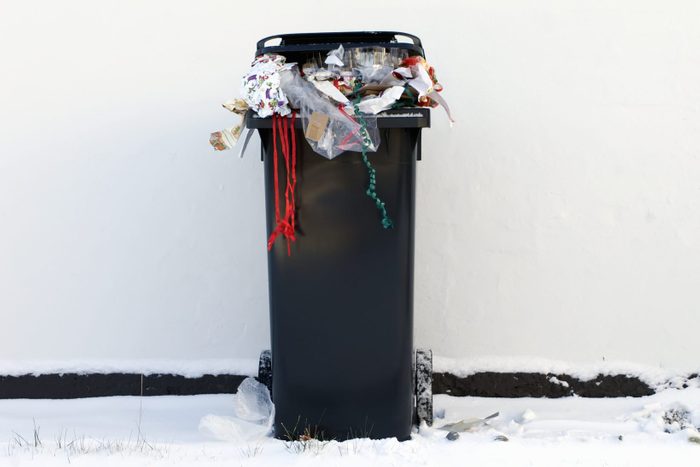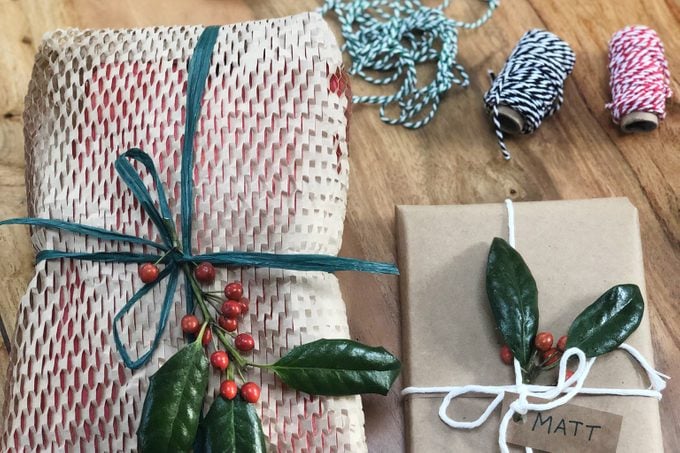11 Simple Ways To Cut Down on Waste During the Holidays

From living trees to secret Santa, here's how to maximize the cheer while minimizing the trash.
Americans generate an extra five million tons of waste during the holidays, tossing out everything from spoiled leftovers to disposable decorations. In fact, one of the biggest sources of waste is our tradition of gift-giving. It all starts with shopping bags, shipping boxes and product packaging.
“Then there’s the wrapping paper, bows, ribbons and tape we use to make them look pretty,” says Stephanie Miller author and founder of Zero Waste DC. “New items we purchase generate waste in all kinds of ways, and sometimes the waste is the gift itself when it isn’t wanted by the recipient.”
Here are some ways to break out of the holiday waste cycle without giving up on the joy of presents and holiday feasts.
Break With Tradition
Shift your traditions by giving fewer gifts. For families with young children, this could mean presents for the kids but not the adults. “This year for the first time ever, our family gathering of 11 people drew names for a secret Santa gift,” says Miller. “Instead of more than 100 gifts, there will be a total of 11.”
Give Consumables
Steer away from plastic. Instead, lean towards gifts like unusual tea collections or cooking salts and spices, which recipients can use in lieu of products they’d be purchasing anyway.
Re-Give
It’s okay to give someone something you are no longer in need of as a gift. As long as you’re not gifting people your unused junk or broken appliances, regifting is a great way to repurpose things in your life into thoughtful gifts. You can also try swapping books as presents.
Make a List
Share a list of items you need or really want, to help your family give you a gift that won’t be wasted. They won’t have to guess what you want, and you won’t have to pretend that you love tacky sweaters and jingle-bell socks.
Give Memories
Our best memories tend to come from experiences, not material possessions. “Ask them to chip in for dinner at a favorite restaurant, tickets to a concert or play, or a subscription to a favorite magazine,” says Miller.
Shop Smart
Shop local to save all of those cardboard shipping boxes. Choose items with minimal plastic packaging, and don’t forget to use canvas shopping bags.
Wrap With Care
Use reusable gift bags to avoid tape, which is never recyclable, and encourage the recipient to use the bags for future gift-giving. Paper bags without metallic embellishments can be recycled. Or try brown craft paper and ribbon made from natural fibers as gift wrap. “Adding some natural sprigs or dried orange slices makes the package even more festive,” says Miller.
Skip the Card
All of those paper cards really add up: If each of us used just one less greeting card, we’d save 50,000 cubic yards of paper each year! Reuse old holiday greeting cards by covering over last year’s message with a fresh sheet of paper, or send out a virtual slide show or group greeting card. If you do use paper cards, avoid any with glitter, foil, audio messages and other decorations. Stuff like that can be harmful to the environment, and they don’t recycle well.
Use a Living Tree
We’ve been decorating the ficus in our living room every year instead of getting a traditional tree, but you could also buy a living pine tree and plant it in the yard afterward.
Plan for Leftovers
If you host a holiday meal, ask guests to bring their own containers to take home leftovers. Likewise, when you attend a holiday meal, bring your own doggie bag. And of course, ditch disposable plates and glasses, and stock up on cloth napkins.
Freeze Leftovers
If you haven’t eaten your leftovers by day three after the big meal, stick them in the freezer. Almost everything freezes well, plus you’ll be doing a bit of environmental good. Food waste goes up by 25% over the holidays, and the methane from food in landfills contributes heavily to climate change.




